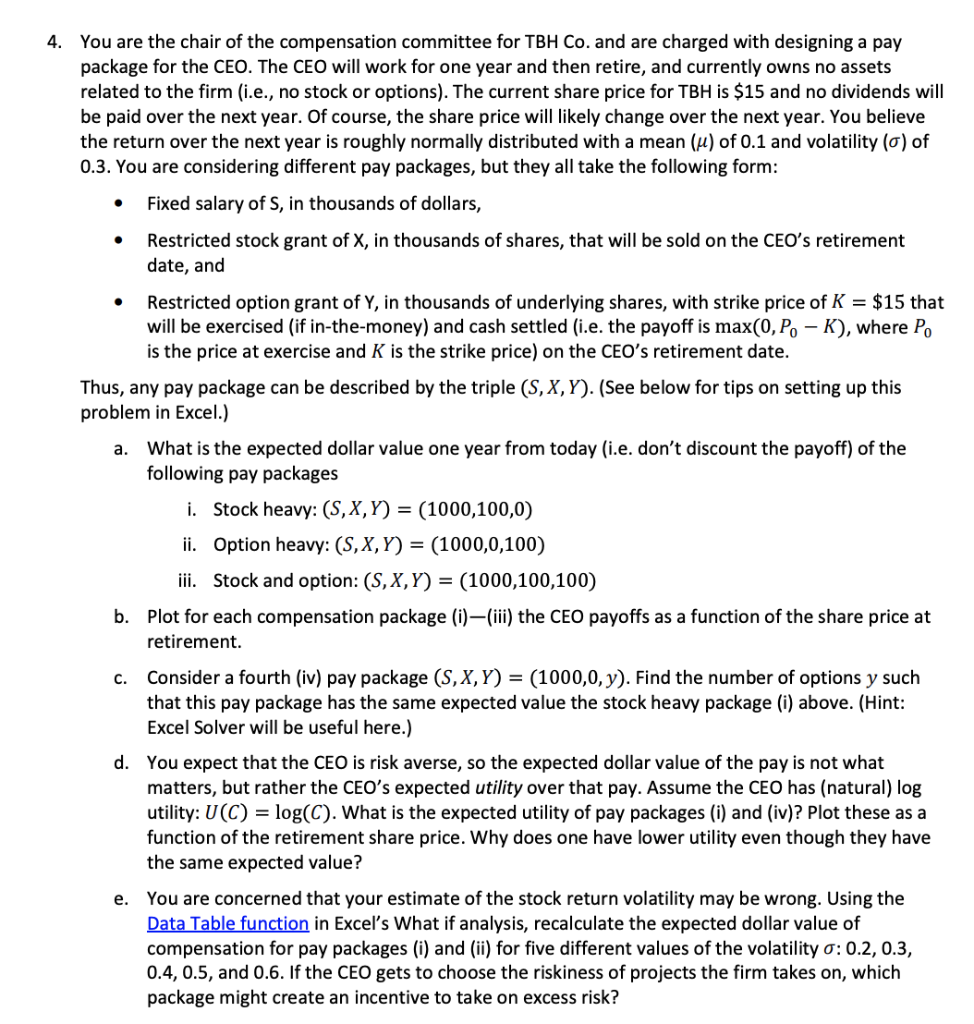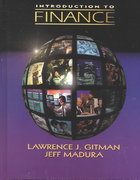
4. You are the chair of the compensation committee for TBH Co. and are charged with designing a pay package for the CEO. The CEO will work for one year and then retire, and currently owns no assets related to the firm (i.e., no stock or options). The current share price for TBH is $15 and no dividends will be paid over the next year. Of course, the share price will likely change over the next year. You believe the return over the next year is roughly normally distributed with a mean (u) of 0.1 and volatility (o) of 0.3. You are considering different pay packages, but they all take the following form: Fixed salary of S, in thousands of dollars, Restricted stock grant of X, in thousands of shares, that will be sold on the CEO's retirement date, and . Restricted option grant of Y, in thousands of underlying shares, with strike price of K = $15 that will be exercised (if in-the-money) and cash settled (i.e. the payoff is max(0, P. K), where Po is the price at exercise and K is the strike price) on the CEO's retirement date. Thus, any pay package can be described by the triple (S,X,Y). (See below for tips on setting up this problem in Excel.) a. What is the expected dollar value one year from today (i.e. don't discount the payoff) of the following pay packages i. Stock heavy: (S,X,Y)= (1000,100,0) ii. Option heavy: (S,X,Y) = (1000,0,100) iii. Stock and option: (S,X,Y) = (1000,100,100) b. Plot for each compensation package (i), (iii) the CEO payoffs as a function of the share price at retirement. C. Consider a fourth (iv) pay package (S,X,Y) = (1000,0, y). Find the number of options y such that this pay package has the same expected value the stock heavy package (i) above. (Hint: Excel Solver will be useful here.) d. You expect that the CEO is risk averse, so the expected dollar value of the pay is not what matters, but rather the CEO's expected utility over that pay. Assume the CEO has (natural) log utility: U(C) = log(C). What is the expected utility of pay packages (i) and (iv)? Plot these as a function of the retirement share price. Why does one have lower utility even though they have the same expected value? e. You are concerned that your estimate of the stock return volatility may be wrong. Using the Data Table function in Excel's What if analysis, recalculate the expected dollar value of compensation for pay packages (i) and (ii) for five different values of the volatility o: 0.2, 0.3, 0.4, 0.5, and 0.6. If the CEO gets to choose the riskiness of projects the firm takes on, which package might create an incentive to take on excess risk? 4. You are the chair of the compensation committee for TBH Co. and are charged with designing a pay package for the CEO. The CEO will work for one year and then retire, and currently owns no assets related to the firm (i.e., no stock or options). The current share price for TBH is $15 and no dividends will be paid over the next year. Of course, the share price will likely change over the next year. You believe the return over the next year is roughly normally distributed with a mean (u) of 0.1 and volatility (o) of 0.3. You are considering different pay packages, but they all take the following form: Fixed salary of S, in thousands of dollars, Restricted stock grant of X, in thousands of shares, that will be sold on the CEO's retirement date, and . Restricted option grant of Y, in thousands of underlying shares, with strike price of K = $15 that will be exercised (if in-the-money) and cash settled (i.e. the payoff is max(0, P. K), where Po is the price at exercise and K is the strike price) on the CEO's retirement date. Thus, any pay package can be described by the triple (S,X,Y). (See below for tips on setting up this problem in Excel.) a. What is the expected dollar value one year from today (i.e. don't discount the payoff) of the following pay packages i. Stock heavy: (S,X,Y)= (1000,100,0) ii. Option heavy: (S,X,Y) = (1000,0,100) iii. Stock and option: (S,X,Y) = (1000,100,100) b. Plot for each compensation package (i), (iii) the CEO payoffs as a function of the share price at retirement. C. Consider a fourth (iv) pay package (S,X,Y) = (1000,0, y). Find the number of options y such that this pay package has the same expected value the stock heavy package (i) above. (Hint: Excel Solver will be useful here.) d. You expect that the CEO is risk averse, so the expected dollar value of the pay is not what matters, but rather the CEO's expected utility over that pay. Assume the CEO has (natural) log utility: U(C) = log(C). What is the expected utility of pay packages (i) and (iv)? Plot these as a function of the retirement share price. Why does one have lower utility even though they have the same expected value? e. You are concerned that your estimate of the stock return volatility may be wrong. Using the Data Table function in Excel's What if analysis, recalculate the expected dollar value of compensation for pay packages (i) and (ii) for five different values of the volatility o: 0.2, 0.3, 0.4, 0.5, and 0.6. If the CEO gets to choose the riskiness of projects the firm takes on, which package might create an incentive to take on excess risk







